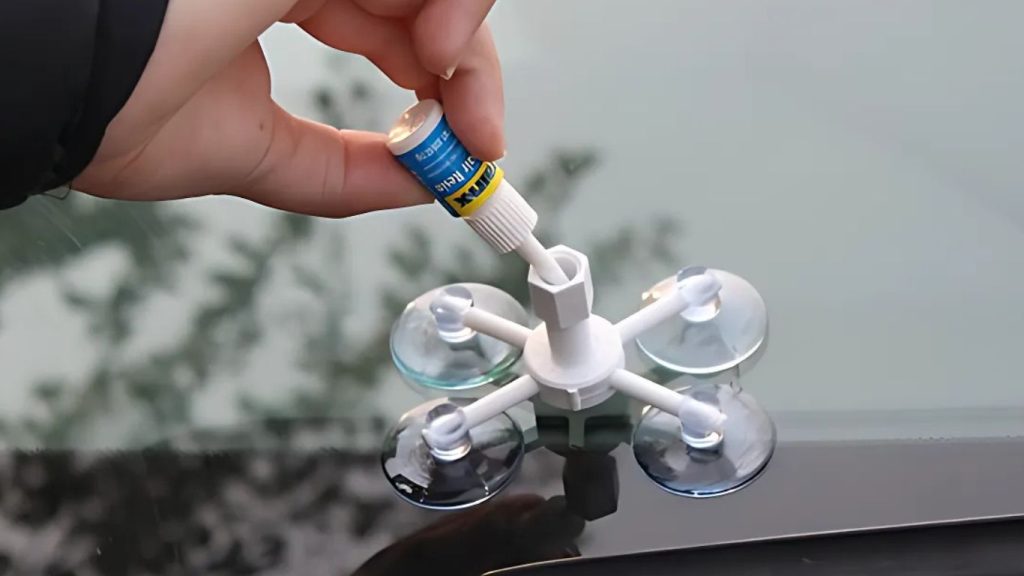A chipped windshield is more than just a cosmetic flaw—it’s a common headache for drivers that can escalate if ignored. A small chip from a pebble or a star-shaped mark from a bigger hit can be fixed easily. Knowing how to repair a chipped windshield can save you time, money, and stress.
Chips in your windshield can get worse over time. This can happen from a stone hitting it or another impact. Were you aware that these chips are repairable? Certain minor windshield chips can even be fixed at home using a repair kit.
- Purchase a windshield repair kit
- Wipe the chip area clean with glass cleaner
- Secure the kit’s adhesive patch and holder over the chip
- Use the syringe to fill the chip with resin
- Let the resin cure under sunlight or a UV light
- Scrape off excess resin and polish the glass
Can You Fix It Yourself? DIY vs. Professional Repair
When you see a chip in your windshield, you might wonder: Can I fix this myself, or do I need help? The answer depends on the size, depth, and location of the damage.
DIY Windshield Repair: When Can You Fix It Yourself?
When you see a chip in your windshield, you might wonder: Can I fix this myself, or do I need help? The answer depeIf the chip is smaller than a quarter and not cracked, you can fix it yourself. Use a windshield repair kit. These kits contain windshield resin, a special liquid that fills the chip and hardens under UV light to prevent further damage.
DIY Repair Steps
- Clean the Chip – Remove any dust, dirt, or moisture from the damaged area.
- Apply the Windshield Resin – Use the included applicator to fill the chip with the repair resin.
- Cure with UV Light – Allow the resin to harden under direct sunlight or a UV lamp.
- Polish for Clarity – Smooth out any excess resin to restore visibility.
When DIY Works
- The chip is small (under 1 inch in diameter)
- The crack has not spread
- The damage is not in the driver’s direct line of sight
- There is no trapped moisture or dirt inside the chip
A good DIY repair can stop a chip from becoming a bigger crack. However, it might not be as strong or hidden as a professional repair.
When Should You Call a Professional?
If the damage is bigger than a quarter, near the edges of the windshield, or has cracks, get a professional repair.
Why Professional Repair is Recommended
- Stronger and More Durable – Experts use industrial-grade windshield resin that bonds better and lasts longer.
- Prevents Further Cracks – Chips near the edges can weaken the entire windshield, increasing the risk of full replacement.
- Better Visibility – DIY kits may leave small marks, while professionals ensure a clear, seamless finish.
If the damage is too severe for repair, a full windshield replacement may be necessary. A cracked or weakened windshield compromises safety, as it plays a key role in structural integrity during accidents.
Step-by-Step Guide to Fix a Chipped Windshield
You can fix a chipped windshield at home if the damage is small, under 1 inch. It should not be spreading and must not be in the driver’s direct line of sight. Using a windshield repair kit, you can prevent further cracks and restore visibility. Here’s a step-by-step guide to help you fix it properly.
Things You’ll Need
- Windshield repair kit (contains resin, applicator, curing strips, and razor blade)
- Microfiber cloth (for cleaning)
- Glass cleaner or rubbing alcohol
- UV light or direct sunlight (for curing the resin)
How to Repair a Small Chip in a Windshield at Home
Step 1: Clean the Damaged Area
Before applying any resin, it’s important to remove dirt, moisture, and debris from the chip.
How to do it:
- Use a microfiber cloth and glass cleaner or rubbing alcohol to wipe the area.
- Let it air dry completely before proceeding.
Why this matters: Any moisture or dirt trapped inside the chip will affect the repair’s durability and clarity.
Step 2: Position the Applicator Over the Chip
Most windshield repair kits come with a bridge applicator or a suction tool to hold the resin in place.
How to do it:
- Align the applicator’s seal directly over the chip.
- Secure the suction cups or adhesive base to ensure it stays in place.
Why this matters: A good applicator helps the resin go deep into the chip. This makes the repair stronger.
Step 3: Apply the Windshield Resin
Resin is the key ingredient that fills the damaged area and prevents cracks from spreading.
How to do it:
- Slowly inject the resin into the chip using the applicator’s syringe or dropper.
- Let the resin settle for at least 5 minutes to ensure it fills all tiny cracks.
- If needed, apply light pressure from the inside of the windshield to help the resin flow.
Why this matters: High-quality windshield resin bonds with the glass, reinforcing the structure and improving visibility.
Step 4: Cure the Resin with UV Light or Sunlight
Curing hardens the resin, making the repair strong and permanent.
How to do it:
- Place the included curing strip (if provided) over the resin.
- Let the resin cure for 10-30 minutes in direct sunlight or under a UV light.
- Once fully cured, the resin should be completely dry and hardened.
Why this matters: UV curing ensures that the resin doesn’t wash away or break down, keeping the repair intact.
Step 5: Remove Excess Resin and Polish the Surface
After curing, any extra resin must be removed for a smooth finish.
How to do it:
- Peel off the curing strip carefully.
- Use the razor blade (provided in the kit) to gently scrape off excess resin.
- Wipe with a microfiber cloth for clarity.
Why this matters: Proper finishing restores visibility and prevents glare or rough spots.
Best Windshield Repair Kits for Small Chips
If you’re considering a DIY repair, here are some highly rated windshield repair kits:
- Permatex Windshield Repair Kit – Affordable and easy to use.
- Rain-X Windshield Repair Kit – Works well for small chips and cracks.
- 3M Windshield Repair Kit – Professional-grade resin with long-lasting durability.
Tip: Always choose a repair kit that includes high-quality resin and a UV curing step for the best results.
Common Mistakes to Avoid When Fixing a Chipped Windshield
❌ Skipping the cleaning step – Dirt and moisture can ruin the repair.
❌ Using too much resin – This can cause bubbling and uneven curing.
❌ Not curing the resin properly – Without UV light, the repair won’t last.
❌ Fixing large or deep cracks yourself – These require professional repair.
Frequently Asked Questions
It’s best to wait at least 30 to 60 minutes after a windshield repair before driving. This allows the resin to fully bond with the glass. If possible, wait a few hours for the repair to cure completely, especially in cold or humid conditions.
A small chip can turn into a long crack over time due to temperature changes, vibrations from driving, and moisture seeping in. If left untreated, the damage may spread, leading to higher repair costs or full windshield replacement.
Yes. Hot weather can make the chip expand. This makes it harder to repair. Cold temperatures can make the glass brittle. This increases the risk of cracking. Ideally, repair the chip in a temperature-controlled environment or follow specific weather-related precautions in extreme conditions.
Some DIY fans suggest using super glue or clear nail polish as a quick fix. However, these are not permanent solutions. They do not bond as effectively as windshield resin and may lead to visibility issues or improper curing. Always use a proper windshield repair kit for best results.
No, even after a proper repair, the chip may still be slightly visible. However, a well-done repair significantly reduces visibility and prevents the chip from expanding. Professional repairs tend to leave less noticeable marks compared to DIY fixes.
Yes, if the repair wasn’t done correctly, or if the windshield resin wasn’t fully cured, the chip may reopen over time. Too much sun, water, and rough roads can weaken the repair. This may require you to reapply resin or get professional help.
A chip or crack may be beyond repair if:
- It is larger than a dollar bill
- The crack has multiple branches or spiderweb patterns
- The damage is located at the edge of the windshield
- It obstructs the driver’s direct line of sight
- In such cases, replacing the windshield is the safest option.
Many insurance companies cover multiple windshield repairs under comprehensive coverage, but policies vary. Some insurers limit how many free repairs you can get each year. Others may ask for a deductible after your first claim. It’s best to check with your insurance provider for specific details.





